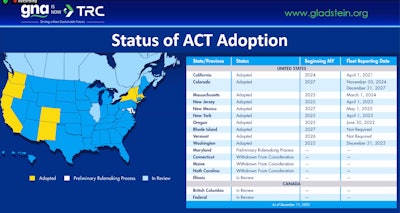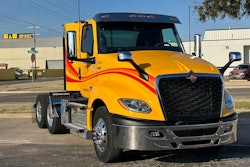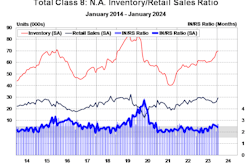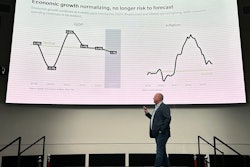
The Motor and Equipment Manufacturers Association (MEMA) kicked off its annual Pulse webinar schedule Tuesday with a busy presentation addressing some of trucking’s biggest issues.
MEMA Senior Manager of Research and Industry Analysis Joe Zaciek kicked off the session, offering industry projections for 2024 and 2025 based on a MEMA’s most recent member survey. Zaciek was then followed by Rebecca Schenker, vice president of regulatory compliance at TRC, who offered a high-level assessment of the many emission and fuel economy regulations that have been implemented by California’s Air Resources Board (CARB) that are not only driving dramatic change into the state’s truck population but also beginning to see adoption in other parts of the country.
Zaciek said MEMA had 55 members respond to its most recent member poll, higher than average, and said sentiment from the members on 2023 and the state of the industry today was mostly muted. He said responders indicated the challenges that plagued their businesses (access to raw materials, labor, inflation) throughout 2022 and 2023 have mostly rescinded, but so has demand. Delivery performances and inventories also have normalized, which is a good sign for manufacturers if the market swings wildly in either direction in 2024.
[RELATED: What's really coming for 2024? Here's a roundup of what we've posted on the months ahead]
On that note, Zaciek said MEMA respondents anticipate if the market shifts at all this year, it will likely be down slightly. He said fewer than 30% of responders expect a recession, and the MEMA survey population averaged a 3.6 (out of five) on its recession preparedness indicator. Zaciek said that means on the whole, suppliers feel they are at least somewhat prepared for a bad stretch if one arises.
Looking to 2025, Zaciek said the industry expects better results.
He said recent survey responders predicted a weighted average of 269,000 units for Class 8 truck production in 2024, with the Classes 5-7 market and trailer sectors expected to be even lower at 250,000 units and 245,000 units, respectively. Expectations for all three sectors are higher for 2025. Zaciek said MEMA’s responders offered weighted averages for 2025 production of Class 8 trucks at 285,000 units, with Classes 5-7 at 267,000 units and trailers at 267,000 units.

Zaciek also admitted “confidence in these forecasts is weak, at best,” but said the relatively consistency of responses across the supplier spectrum indicates most businesses are expecting the similar conditions for the months ahead, as there are very few outliers on either end.
California regulatory synopsis
Schenker followed Zaciek with a race through the many CARB regulations impacting the trucking industry in 2024 and beyond. Most of her time was spent on the Advanced Clean Fleets (ACF) and Advanced Clean Trucks (ACT) rules, which require fleets and manufacturers to adopt and sell a certain percentage of zero-emission vehicles (ZEV) beginning this year, with a goal of 100% ZEV adoption in the state by 2045. Schenker said the focus on ZEV is a change from CARB’s efforts from 2010 to 2022, when it mostly focused on driving emissions down as much as possible for internal combustion engines.
“California is focused on zero. Clean diesel is not clean enough anymore,” she said.
Schenker said while California is currently the only state to implement its ACF, ACT and other commercial truck emission rules (such as its low NOx Omnibus mandate), across the U.S. and Canada more than a dozen other states and provinces have signed a Memorandum of Understanding (MOU) to adopt future CARB regulations in the future. Schenker did note without legislation or regulatory commitment to those MOU statements, “they’re just words,” but also stated the willingness of so many states to follow at least some of CARB’s regulations means the trucking industry can’t view the regulations as isolated, one-off challenges.
[RELATED: California truck dealers stressed by state's new regulations]
Among California’s newest rules, Schenker said ACT has the broadest national support among state governments, with some intending to adopt the regulations as early as next year. She also said many manufacturers are attempting to meet their earliest ACT requirements by leveraging emissions credits previously earned to limit their ZEV sale requirements. Credits also can be used within the Omnibus program, so manufacturers can avoid a delay in the delivery of new equipment before their model year 2024 CARB-compliant low NOx engines are readily available.

On the ACF side, Schenker said fleets have a choice to go with a model year or ZEV compliance schedule, and most are choosing the latter. She said this strategy requires fleets to begin adding new ZEV equipment this year, but only in specific weight classes and at very small levels. She said fleets view this as a better option than the model year route, which effectively eliminated the ability for a fleet to buy a new internal combustion engine beginning on Jan. 1, 2024.
Schenker also noted in closing CARB is allowing some flexibility in enforcement for companies that are doing their due diligence to meet the requirements but have been met with realistic setbacks. She said state regulators can be lenient for businesses who want to follow the regulations but will not tolerate businesses that actively attempt to circumvent the new rules.











